Yesterday I attended Shotgun Skills with FPF Training. Taught by Tim Chandler and Ashton Ray, this is my first formal shotgun class. Bottom line up front: if you’re looking to improve your existing shotgun skills or gain new ones, if you want to tame the monster and turn it into a pet, you should consider this class.
This article contains affiliate links.
Full Disclosure: I paid full price for this class. This review was not coordinated in any way with FPF Training, Tim Chander, Ashton Ray, or 360 Performance, and I received no incentives, financial or otherwise for publishing this review. This is article contains my own unfiltered thoughts and opinions about this class.
My Pet Monster
First thing in the morning, just prior to commencing the safety brief, Tim opened with a little talk about the shotgun. He said that being good with a shotgun is, “like having a pet monster. You can point it and upon command unleash tremendous power.” I hope Tim isn’t cringing that I latched onto this particular analogy, but I really enjoyed it. Right out of the gate it got us into the headspace of operating such a powerful firearm.
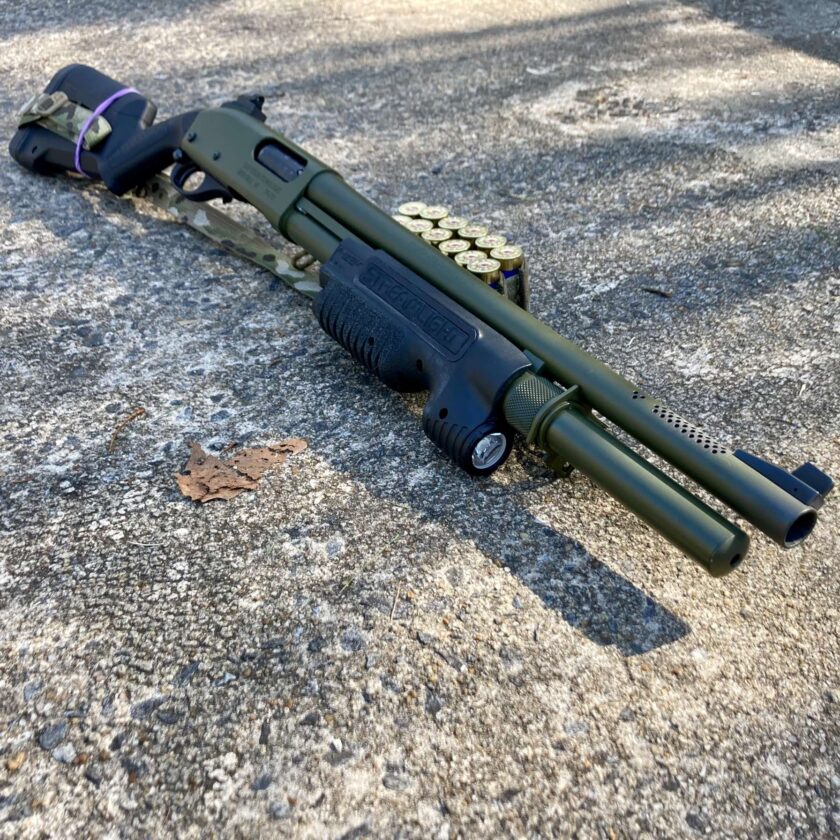
It also more or less describes the raison d’être of the shotgun. The “properly loaded, intelligently wielded shotgun” does hold tremendous fight-stopping power. Tim reasoned that if someone is doing something that causes a responsible citizen to respond with gunfire, it is reasonable to want a firearm that ends the fight as quickly and with as few rounds fired as possible. There are no man-portable weapons to my knowledge that equal the fight-stopping capability of the 12-gauge shotgun. The shotgun is incredibly powerful.
The real beauty of this class is that you won’t leave with a bruise on your shoulder, and you won’t flinch every time the shotgun comes out. The techniques taught in this class truly make the shotgun a pet and a pleasure to shoot, which leads to confident, accurate shooting.
After this little pep talk the class began! Let’s cover some administrative details, then get into the run of show.
Admin Details
The class was held at FPF Training Center in Culpeper, VA. This is my second course there, the first being a revolver course with Chuck Haggard, way back in to 2019 (RevolverGuy was there, too). Tim Chandler was actually an assistant instructor on that course, so he wasn’t a total stranger to me. His assistant this time was Ashton Ray of 360 Performance. I had not met Ashton previously and unfortunately his web presence is via social media. If you don’t know who Tim and Ashton are, check out this video.
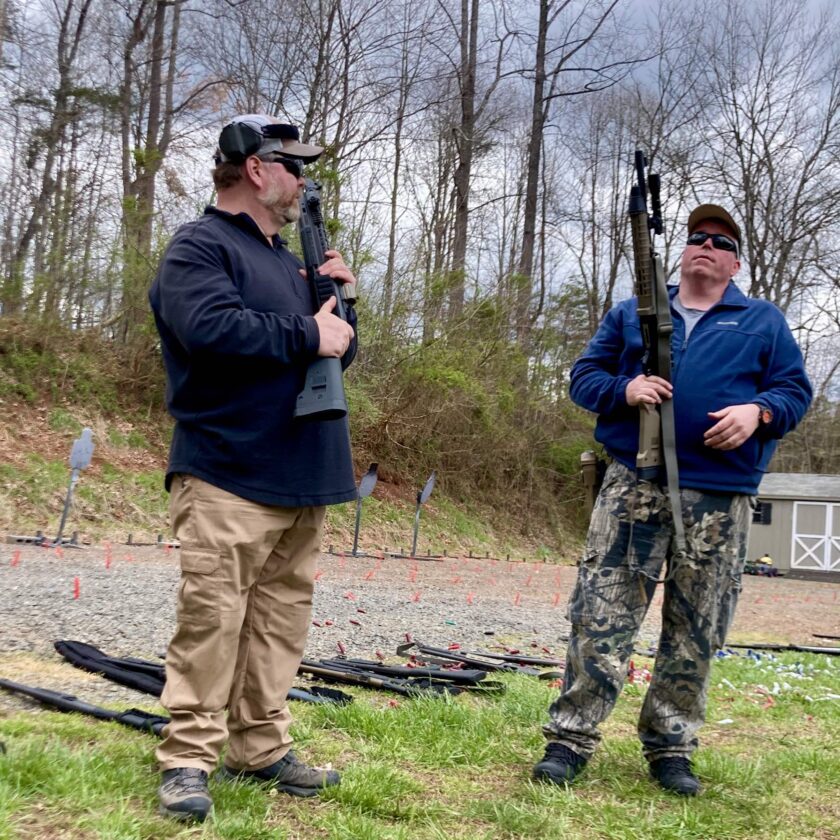
The course cost was $200. This is a really, really inexpensive class for the knowledge and attention that you get. If you live within, say four hours of Culpeper you really need to get to this class. Instead, I drove seven hours and spent two nights in a hotel to facilitate my own attendance, and that of a friend who came with me. If you’ve never been to FPF before, the meetup is a 7-11 with a convoy to the range.
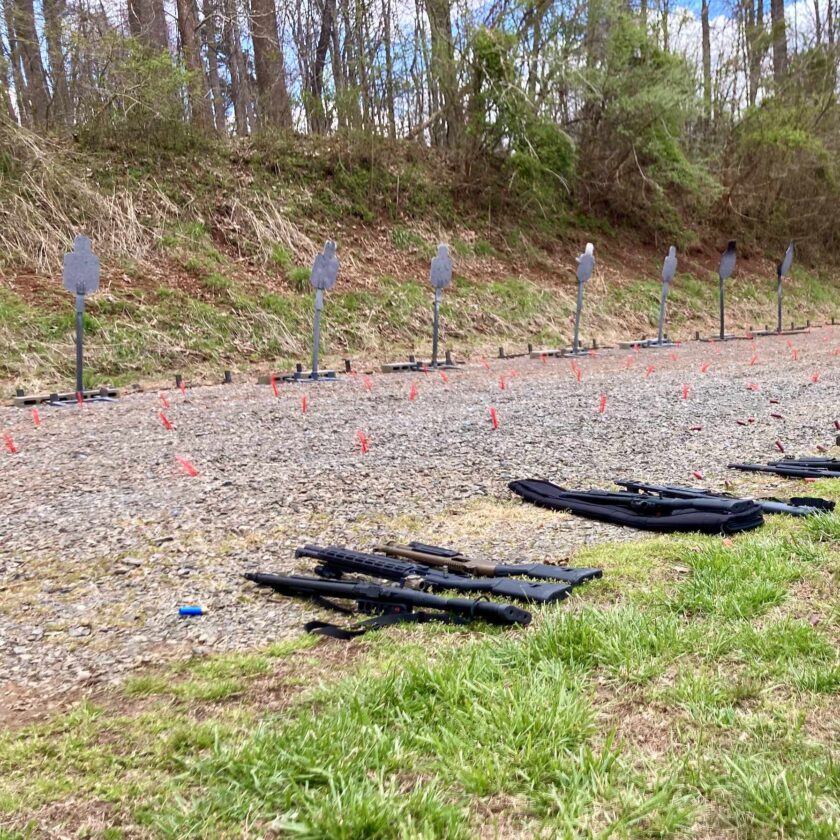
The gear list was pretty simple: a serviceable shotgun, eye and ear pro, BYO lunch, etc. The initial ammo requirement was 125 birdshot and 125 buck, but closer to range day an email asked us to bring 200 round of birdshot 25 buck, and a few slugs. I didn’t have a problem acquiring the initial requested amounts online, but we ended up shooting far less than either list specified (this is fine by me; I’d rather take ammo home than have a SPENDEX at the end).
Class started at 9 and wrapped up sometime around 5. Let’s get into the meat and potatoes.
Shotgun Skills: Safety Brief
The class began promptly at nine. I was really happy to see this as it’s not always the case. By 09:01 the safety brief was starting. I’ll be honest: sometimes I get frustrated with safety briefs. Sometimes – not always, but sometimes – safety briefs are done oh-so-wrong. They are either glossed over, or treated as a power trip by the instructor. This was one of the most intelligent safety briefs I’ve ever attended.
First, it wasn’t a recitation of Cooper’s Four Rules, as the Colonel handed them down on the stone tablets. Instead it was a very intelligent treatment of the rules. For instance, “treat every weapon as if it were loaded” was actually treated with some nuance and became, “know the condition of your gun and make sure it is appropriate for your intended use.” An “appropriate condition” for cleaning is not the appropriate condition for duty gear while on patrol or a home defense gun in it storage location.
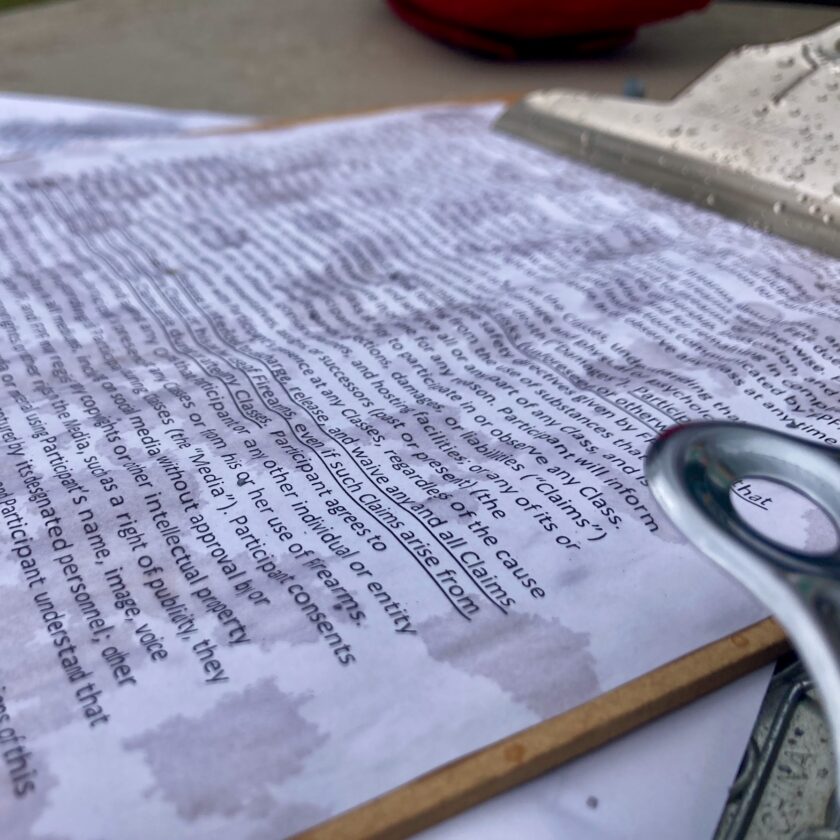
I won’t belabor each safety rule because I’m sure I wouldn’t quite do it justice. It sounds funny to say, but this was almost worth the cost of the course alone because, as Tim and Ashton pointed out, these aren’t range rules. These are life rules, applicable at all times. I came away with the idea that these are guiding principles of firearms use/handling, not just black-and-white rules that aren’t adaptable to every situation.
At the end medics were assigned (me and the other paramedic who came with me) and the medevac plan was issued. According to my notes the safety brief wrapped at 09:41. After a quick pee break we went to the line and shotgun instruction began.
Shotgun Skills: Basics
We stepped to the line and Tim began explaining the basics of shooting a shotgun. This mostly boiled down to three things. The first was stance: fix your feet, fix your hips, weld the gun to your shoulder. I personally got quite a bit out of this. The recoil of pistols and carbines can largely be mitigated by strength and decent technique. The thing Ashton really helped dial in for me was the footwork and getting my toes pointed toward the target, thus closing my hips.
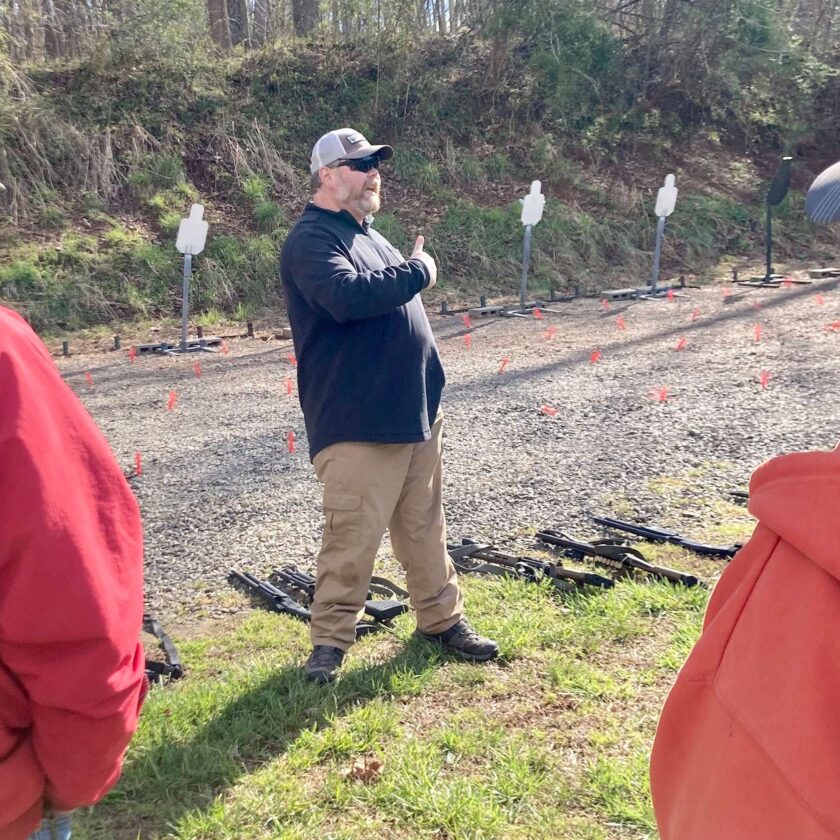
Next up was mounting the gun. This wasn’t terribly new territory to me and I actually got used as a demonstration at the end of the class. One thing I did really appreciate was the explanation of mounting the gun. Rather than drop one’s head the gun sights, raise the gun and “interrupt the eye-target line” with the sights. This is such an elegant and eloquent way to explain this; I think everyone in the class was able to easily conceptualize it.
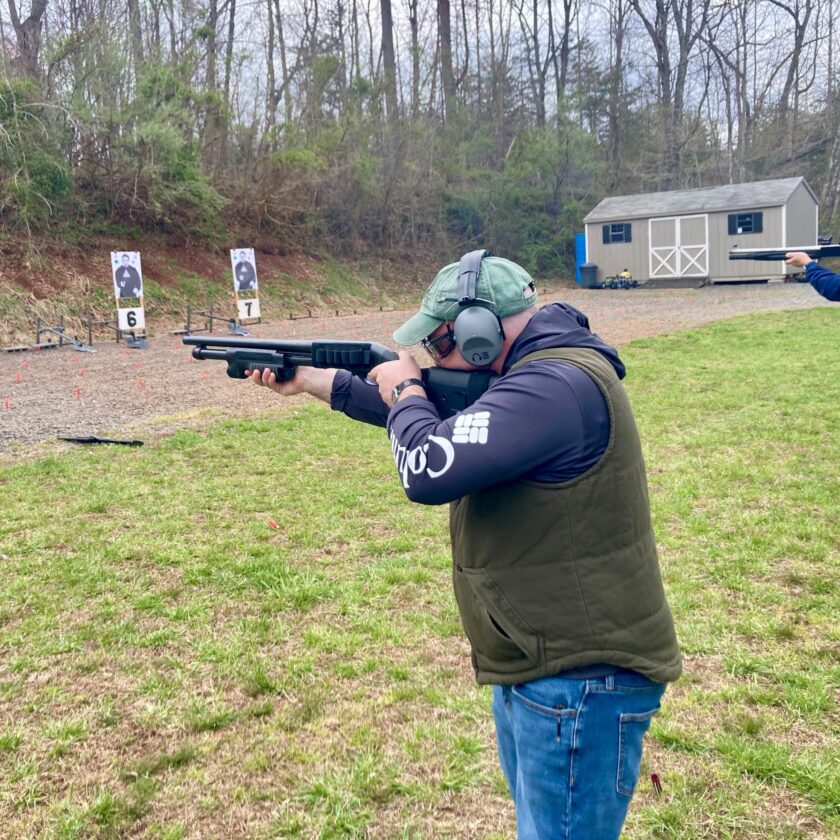
Next up was the part of the class that I came to hone: the famous push-pull technique. I have definitely mentioned this technique here before but if you not heard of it, check out 22:48 in this video from Chris Baker. The push-pull technique will tame the shotgun and make it really pleasant to shoot, and let you get really fast followup shots.
One thing I have struggled with push-pull is strength and fatigue. It’s tiring over a long range session. The thing that Tim and Ashton made clear in Shotgun Skills is that push-pull happens for an instant in time, and it’s not a position you maintain for a long period of time. Your leading arm pushes out as your trigger finger pulls back; once the shot breaks, you’re done. This helped me immensely.
Shotgun Skills: Reloading
Next we got into manipulations. We covered several things under this banner, beginning with reloading. We started with emergency (chamber) reloading. Next we covered elective (i.e. when you get a chance) reloading of the magazine tube. I’m sorry but I don’t have the bandwidth to cover specific techniques here – if you must know go take a class, or at least read a decent book. There wasn’t much new or groundbreaking here, but I did come away with a new appreciation for shotgun capacity “limitations.”
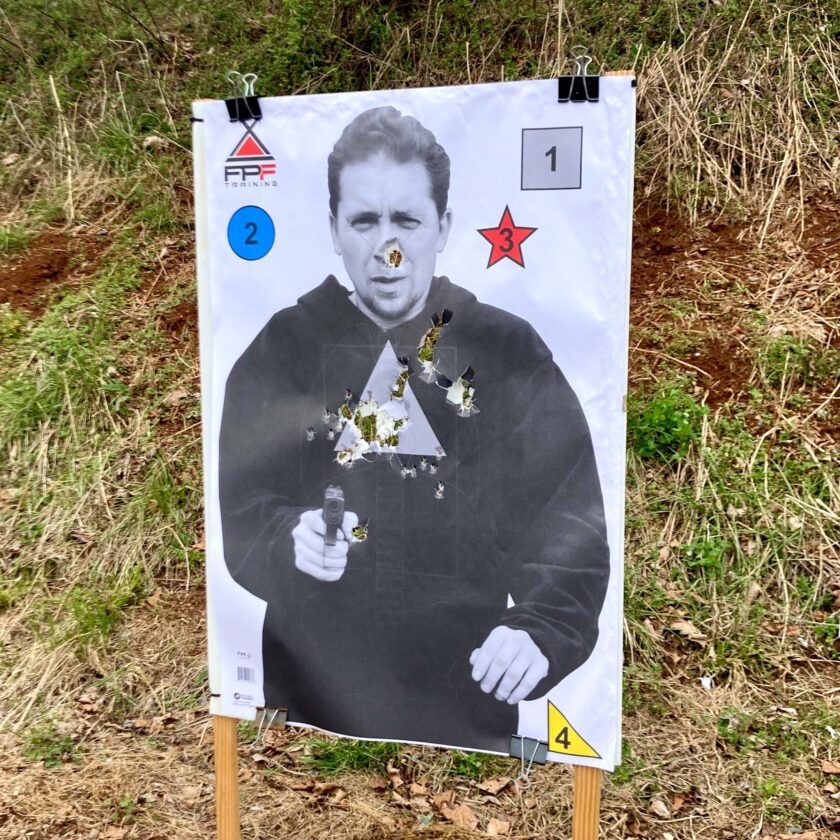
I covered this a few weeks ago in my article Shotguns are Not Low Capacity Weapons but Ashton gave me a better way to explain this: serving size. A Glock 17, for instance, holds 17+1 rounds. It usually takes somewhere in the neighborhood of 5-6 rounds to reliably stop the average bad buy with a pistol, meaning the Glock’s big magazine divided by 6 rounds, contains about 3 “servings.” An AR-15 with a 30-round magazine usually takes 5-6 rounds to reliably put down a bad guy. Divide that into 30 and an AR holds 5-6 “servings.”
A shotgun, on the other hand, takes one round to reliably put down a bad guy. Ergo, my 6+1 shotgun holds 7 servings. And guess what? It gets better! Unlike an AR, you can actually top off a shotgun’s magazine as you go along – you don’t have to discard and replace the entire magazine. Keeping the shotgun loaded is the name of the game and as Tim repeatedly told us, the shotgun is always hungry! We did several rolling thunder drills to reinforce this. Always keep something in the chamber, keep the magazine topped off, and keep replacing rounds in the side-saddle.
Working Lunch
Then we broke for lunch. This was a “grab your lunch, grab water, and grab a chair” working lunch. As Tim said, “we work, you lunch.” While we ate Tim and Ashton talked. They discussed gear (sights, lights, stocks, slings, etc.). I was trying to be a good student so I bit my tongue on a couple things, but I’ll address one of them now.
I didn’t differ with much, but I wouldn’t be a gun guy if I didn’t disagree with something. Lately I am noticing something that is consistently overlooked in a discussion of slings: weapon retention in hands-on confrontations. As Tim explained in the class, a civilian home defender is unlikely to have a pistol to which to transition. Unfortunately, there is also a greater-than-zero chance that any home defense situation will become a hands-on affair. This chance rises if you’re moving through the house.
As Tim also stated, “I brought the shotgun for me, not for anyone who wants to use it.” I have some combatives training and I’ve been punched in the face a time or two. Still, I don’t want to fight for my shotgun because – again – then there is a greater-than-zero chance I’ll lose it. I have some skill, but how much does that matter against someone with 50 lbs on me? What about 100? What if they’ve been doing meth for two days, or manage to clock me with a frying pan? Will I still be able to hang onto my shotgun? If I lose the shotgun, what does that mean for me? For my family?
Personally, I see value in having the gun attached to my body via a sling. My sling isn’t really for resting the gun or transitioning to a pistol, it’s for keeping the gun attached to my body. Unfortunately I’ve not heard that application of the sling even acknowledged by the modern shotgun cognoscenti. Yet.
Shotgun Skills: Transitions, Short-Stocking, & Patterning
After lunch we jumped into an iteration of target transitions. This was good stuff but those of you with a solid background in pistol and rifle target transitions already know what to do: lead with your eyes, follow with the gun. Next up was something I’ve as yet only dry-practiced: short-stocking. If you don’t know what this technique is, check out this video from Lucky Gunner. I walked away from the class feeling very, very comfortable with this technique.
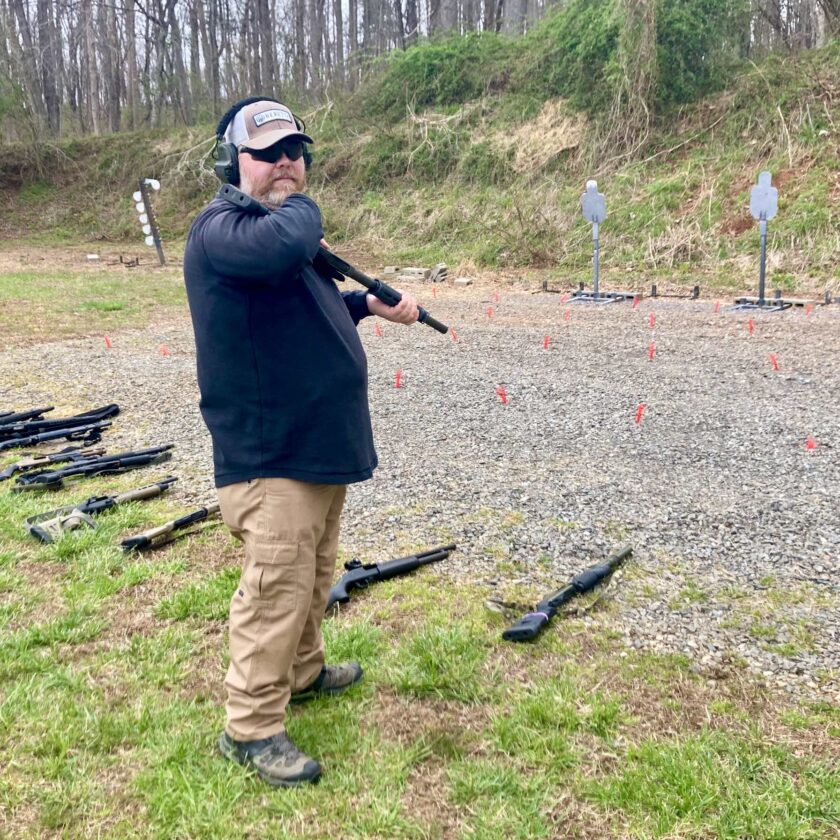
The end of the day saw us patterning. Since my shotgun doesn’t pattern worth a crap with buckshot of any kind, I just shot a group with slugs. That’s what I load my shotgun with anyway (this article explains, intelligently, why). This was a worthwhile exercise as some attendees validated excellent combinations of gun and ammo, and others saw the shortcomings of their chosen loads.
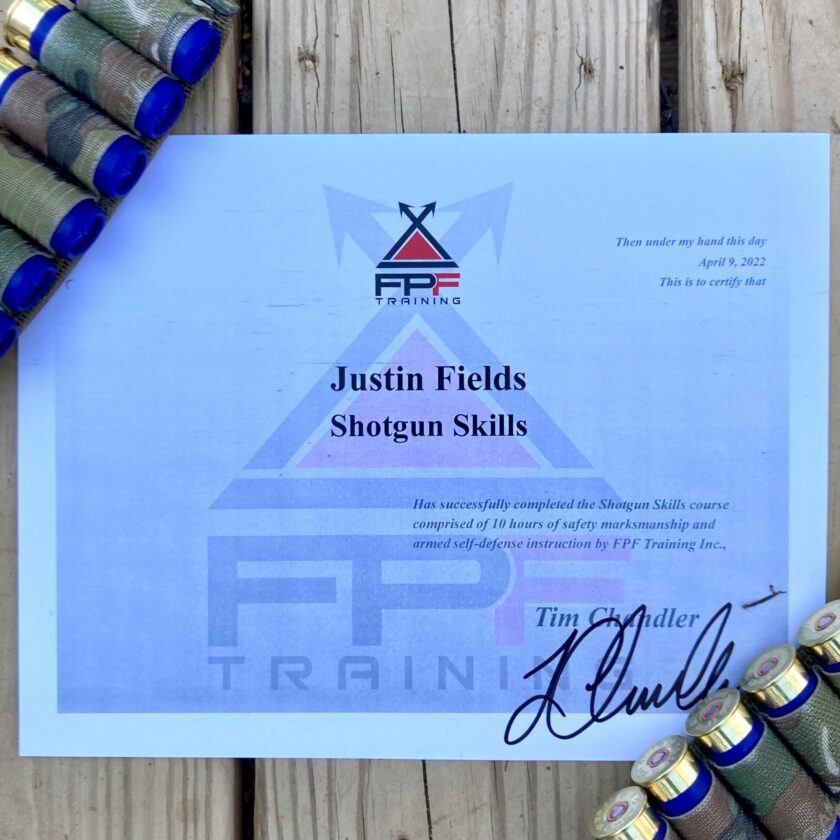
After that the class wrapped up, the range was cleaned, and certificates were handed out. I’ll cover gear quickly (because who doesn’t want to read about gear) then we’ll finish this thing up.
Shotguns and Gear
Let’s talk about the shotguns. The majority of shotguns there were Remington 870s in some form or fashion. These ranged from basically stock shotguns through highly customized versions. If you look closely at the picture I’m sure you’ll see several 870s in various stages of customization.
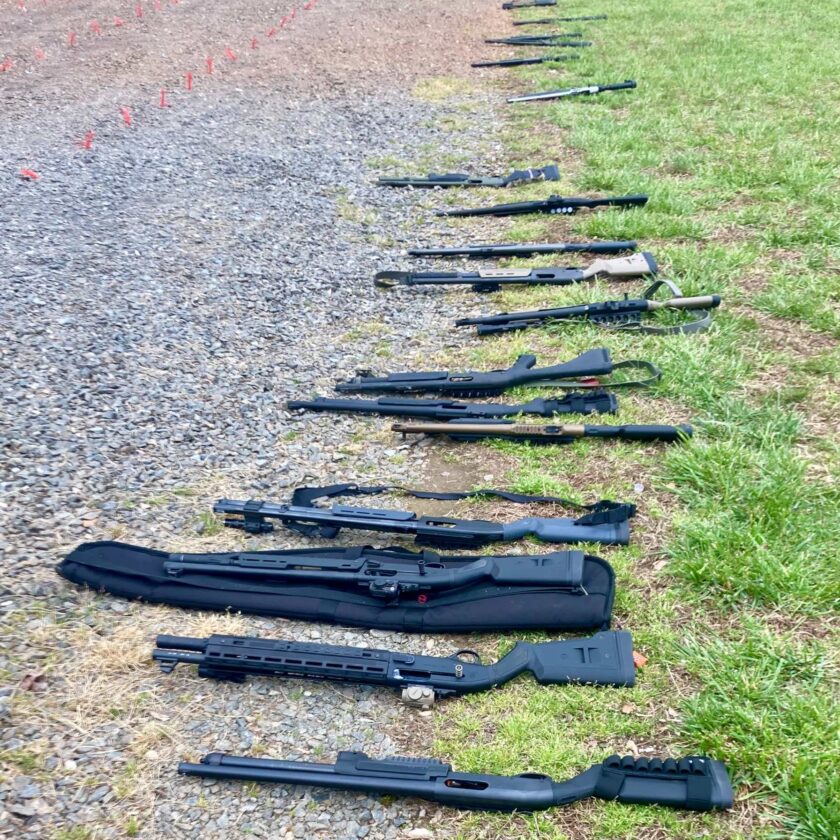
In second place were the Beretta 1301s. The 1301 Tac is a super popular semi-auto that may overtake the pump gun in the not-so-distant future. I shot one at the end of the class and to be honest, I’m glad. I’ve sort of been lusting after a 1301 but after shooting my 870 all day I’m fine with my pump-operated pet monster. One 870 did fail, a 14″, police department issued gun. Fortunately the shooter had a backup shotgun.
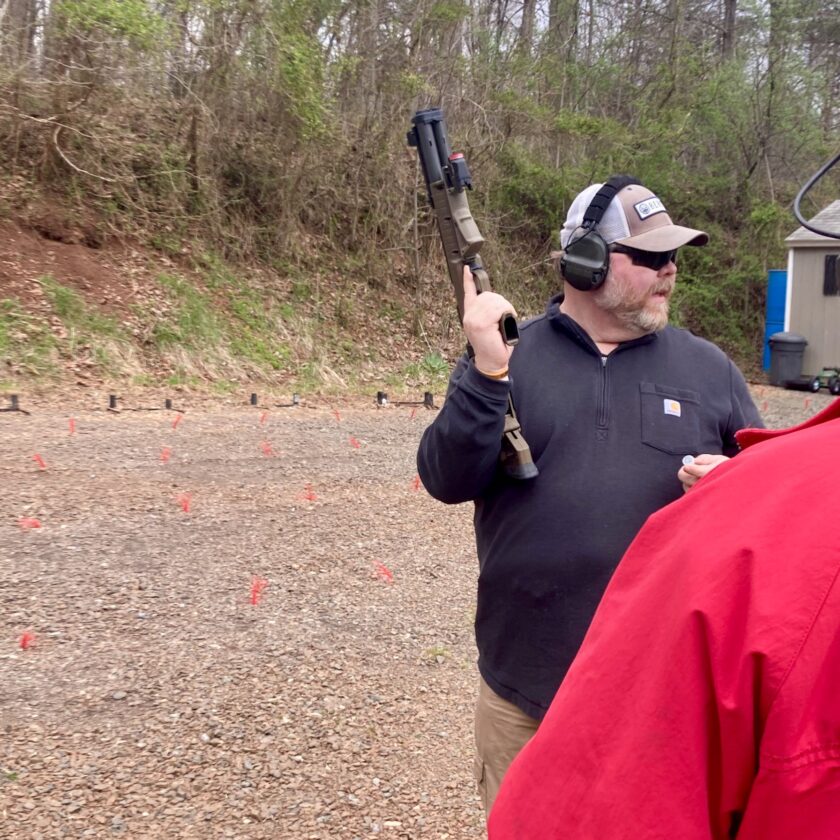
Bringing up the rear were the Mossberg shotguns. There were, I think, two in the class. I wasn’t near either of them on the line, so I don’t have a whole lot to say about them. There was one Kel-Tec KSG, and it failed in the class. Fortunately its owner had a backup, conventional pump gun that worked for the rest of the day.
Among staff and students alike the Magpul SGA stock ruled the day. Probably 9 out of 10 shotguns there had an SGA stock. Ammo wise, most shooters also patterned some version (8- or 9-pellet) of Federal Flite Control ammo. I tend to believe that most of the folks showing up at this class are already pretty shotgun savvy and had done some solid research in selecting their shotguns and accessories.
Gear
I used my Scattergun Technologies (built after acquisition by Wilson Combat) 870. It wears a Magpul SGA stock and a Streamlight TL-Racker forend. I used ESSTAC shotgun cards and a VTAC sling. The only part of this equation that didn’t work perfectly was the Streamlight forend/light.
My Streamlight TL-Racker isn’t ideal for the push-pull technique. I’ve modified it but it’s still not quite there. But guess what? I was still able to make it work pretty well. I’m probably not running to the gun to 100% of it’s capability, but I’m probably not there as a shotgun practitioner, anyway. Still, I’ve got some more work to do at finding a decent light solution. I just can’t abide the thought of throwing a twice-the-weight-half-the-lumens-three-times-the-cost Surefire on there. At least not until I exhaust all other reasonable options.
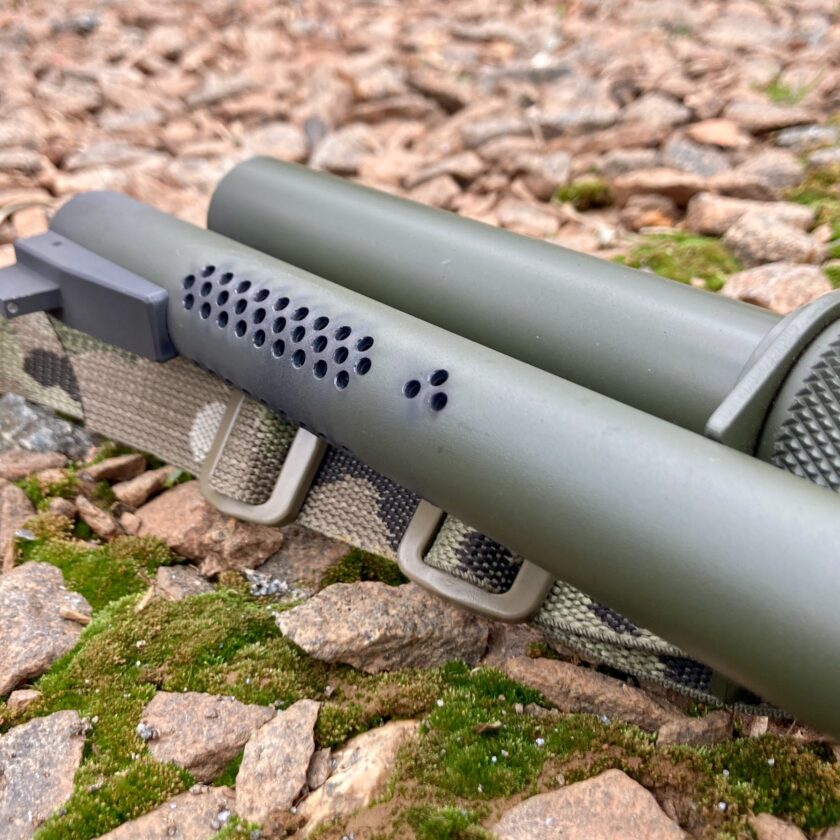
The other issue was already known to me: my shotgun patterns way worse after treatment by Vang Comp. Tim stated this was not abnormal – some shotguns don’t do well with the treatment. My advice is this: if your shotgun patterns well with Flite Control ammo, leave it alone. My patterns with Flite Control were as good as any, but are absolutely terrible post-treatment. This is one of the biggest reasons I use slugs in my shotgun.
The Bottom Line
In my opinion his was an outstanding class! I’ve been to a lot of classes and this was among the best. It started on time, the range was set up in advance. students’ time wasn’t taken doing admin stuff. There was adequate staff and ample instructor-to-student ratio. And the instruction was tip-top.
What about the friend who came with me? This was his first ever formal firearms class so I was definitely curious to get his opinion. He appreciated the class and much to my relief told me that it was absolutely worth the expense and travel time and inconvenience. In his own words, “I’d do it again in a heartbeat.”
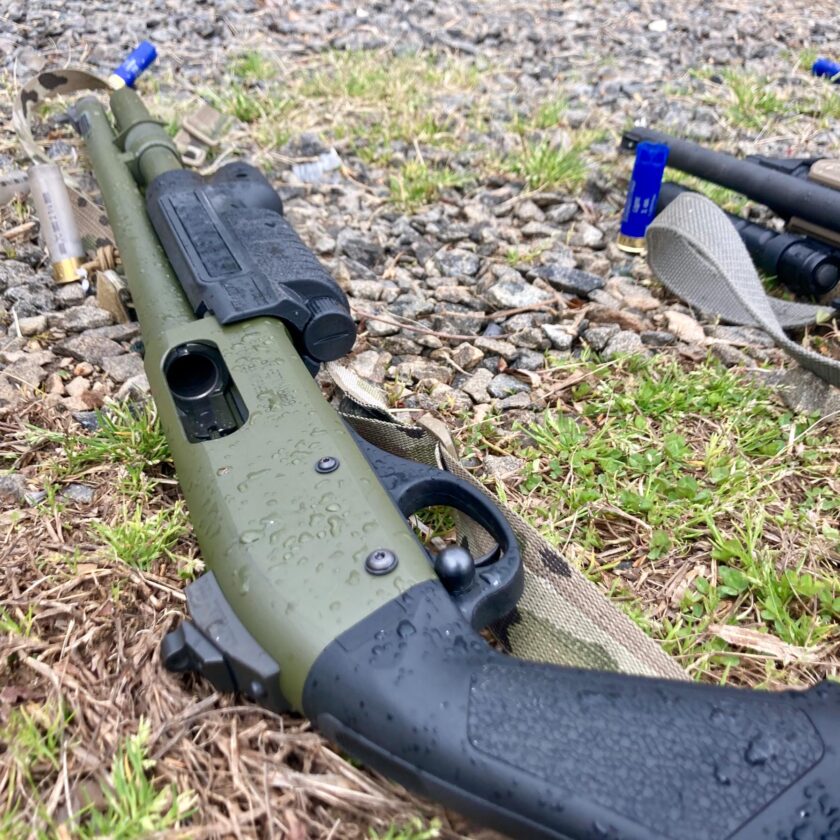
This class covered all the stuff I wanted to go over with a shotgun that was reasonable to cover in a single-day class (I’d love to get into single-handed manipulations, etc.). I would highly recommend Shotgun Skills with FPF training – and specifically with Tim Chandler and Ashton Ray – to anyone looking to develop a better relationship with their pet monster.





